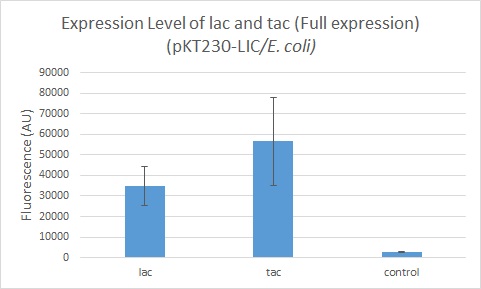Part:BBa_K1856005
lac-citrine
lac promoter assembled to citrine and T7 terminator
Usage and Biology
lac is an inducible promoter native to E. coli. This promoter is induced by the sugar lactose as well as IPTG. The Yale iGEM team has assembled this promoter to citrine (an improved version of YFP, with excitation peak at 514nm and emission peak at 527nm) and a T7-terminator to quantify the level of expression in E. coli and in non-model organism hosts.
This construct has been successfully cloned into E. coli using the broad-host range vector pKT230, a RSF1010 derived plasmid, as well as using the pPZP200 plasmid which can be transformed into agrobacterium and rhizobium. Leaky expression of citrine was observed.
RSF1010 plasmids belong to the IncQ group and can be transformed into a wide range of gram-negative bacteria as well as some gram-positive bacteria. These include cyanobacteria genera such as Synechocystis, Synechococcus and Anabaena, rhizobium genera such as Rhizobium and Sinorhizobium, and other genera such as Pseudomonas, Streptomyces and Mycobacterium. The plasmid is mobilizable by conjugation.
We have used a derivative of pKT230 that is compatible with ligation-independent cloning using BsaI. pKT230 has a kanamycin-resistance marker.
pPZP200 is a agrobacterium binary plasmid that can also be transformed into rhizobium genera. We also used a derivative that is LIC compatible for high-efficiency cloning of our constructs. pPZP200 has a spectinomycin-resistance marker.
Beyond the E. coli work, the construct has also been successfully cloned into S. meliloti and PCR-verified.
Characterization
Measured strength
At full induction, expression level 12.9 times above the baseline was observed in E. coli. The construct was transformed into S. meliloti, but no fluorescence was observed.
These fluorescence readings are part of a series of readings taken using different inducible and constitutive promoters to drive citrine expression. See parts K1856000, K1856002, K1856003, K1856004, K1856005, K1856006 for details of the full characterization set.
Obtaining the lac promoter-citrine construct
The sequences of construct can be found via the table below. The physical DNA can be obtained from:
Via request: The Yale iGEM team has the construct cloned into the broad-host range plasmid, pKT230, a RSF1010 derivative. This plasmid is known to work in cyanobacteria genera such as Synechocystis, Synechococcus and Anabaena, in rhizobium genera such as Rhizobium and Sinorhizobium. The team has also cloned the construct into pPZP200. Both are extremely versatile expression vectors. Please contact the Yale team if you would like to request for an aliquot of the constructs in these plasmids.
Via the Registry distribution: The constructs are included in the Registry distribution, cloned in pSB1C3 backbone.
Sequence and Features
- 10INCOMPATIBLE WITH RFC[10]Illegal EcoRI site found at 1956
- 12INCOMPATIBLE WITH RFC[12]Illegal EcoRI site found at 1956
Illegal NotI site found at 1981 - 21INCOMPATIBLE WITH RFC[21]Illegal EcoRI site found at 1956
Illegal BamHI site found at 1950
Illegal XhoI site found at 1990 - 23INCOMPATIBLE WITH RFC[23]Illegal EcoRI site found at 1956
- 25INCOMPATIBLE WITH RFC[25]Illegal EcoRI site found at 1956
- 1000COMPATIBLE WITH RFC[1000]
| None |

